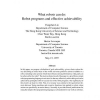242 search results - page 32 / 49 » Zigzags in Turing Machines |
ISAAC
2004
Springer
14 years 1 months ago
2004
Springer
We propose a model of computation where a Turing machine is given random access to an advice string. With random access, an advice string of exponential length becomes meaningful ...
SIGCSE
1999
ACM
13 years 12 months ago
1999
ACM
An automata theory course can be taught in an interactive, hands-on manner using a computer. At Duke we have been using the software tool JFLAP to provide interaction and feedback...
VL
1998
IEEE
13 years 12 months ago
1998
IEEE
We introduce visual graphs as an intermediate repren between concrete visual syntax and abstract graph syntax. In a visual graph some nodes are shown as geometric figures, and som...
KR
1998
Springer
13 years 12 months ago
1998
Springer
In this paper, we propose a definition of goal achievability: given a basic action theory describing an initial state of the world and some primitive actions available to a robot,...
SIGCSE
1997
ACM
13 years 12 months ago
1997
ACM
We present a collection of new and enhanced tools for experimenting with concepts in formal languages and automata theory. New tools, written in Java, include JFLAP for creating a...

